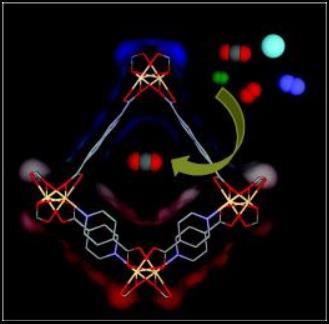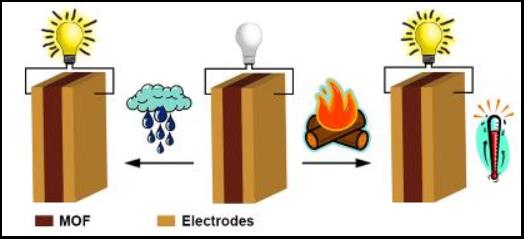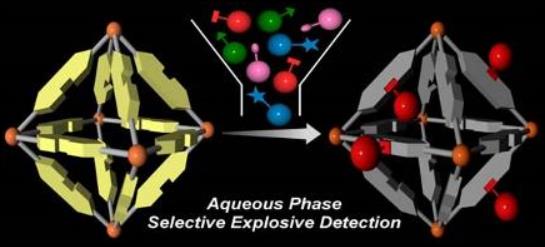|
|

|
Contact address:
Dr. Sujit K. Ghosh Dr. Homi Bhabha Road Pashan, Pune- 411008, India Tel: +91 20 2590 8076 sghoshchem[a]gmail.com |





|
CO2 Storage and Separation: The field of developing new-generation MOF materials for CO2 storage and separation has tremendously evolved over the last decade as one of the frontiers to tackle energy and environmental issues concerning the green-house gas CO2 emission. We are working in this field to synthesize porous MOFs with electron-rich pore surface for selective CO2 uptake over N2, H2, Ar, CH4 gases. We are also in the process of utilizing the dual functionalities of open metal sites and secondary functionalities (like amine, hydroxy) present in MOFs for achieving selective CO2 capture over potentially competing flue gases (Fig. b). Representative Publications: 1. Selective CO2 Adsorption in a Robust and Water-Stable Porous Coordination Polymer with New Network Topology, Inorg. Chem. 2012, 51, 572 Weblink 2. Bi-porous metal-organic framework with hydrophilic and hydrophobic channels: selective gas sorption and reversible iodine uptake studies, CrystEngComm, 2013, 14, 9465 Weblink |
|
Fuel Cell Membrane: Fuel cells have shown great potential to produce energy in higher efficiencies with no environmental pollution. H+ and OH-conduction properties of MOFs evolved as an outcome of some design-principle, coupled with those subsequent to post-synthetic modification (PSM) are currently being studied for intriguing revelation of high proton conductivity and chemical stability features in both anhydrous and humidified conditions. Representative Publications: 1. Two-in-one: Inherent Anhydrous and Water-assisted High Proton Conduction in a 3D Metal-organic Framework, Angew. Chem. Int. Ed. 2014, 53, 2638 Web link 2. Coherent Fusion of Water Array and Protonated Amine in a Metal-Sulphate Based Coordination Polymer for Proton Conduction, Inorg. Chem. 2015 (Just accepted). |
|
Fluorescence-based Sensor : MOF as a chemical sensor has been employed for multiple applications like explosive detection, in vivo neurotransmitter sensing and ion recognition. Chemically stable Zr(IV) and carboxylate based porous fluorescent MOF with free Lewis basic functional groups (like amine, pyridyl ) has been developed for highly selective nitro explosive detection in aqueous phase. A bio-compatible Zr(IV) and carboxylate based MOF based turn-on probe for detection of gasotransmitter H2S in live cells has also been established in our lab. Several other fluorphore-based MOF probes are being studied for diverse sensing and detection purposes, accompanied with high selectivity and sensitivity. Representative Publications: 1. Highly Selective Detection of Nitro-Explosive by a Luminescent Metal-Organic Framework, Angew. Chem. Int. Ed. 2013, 52, 2881 Weblink 2. Aqueous Phase Nitric Oxide Detection by an Amine Decorated Metal-Organic Framework, Chem. Commun. 2015, 51, 6111 Weblink |
|
Major Research Areas: # Metal-Organic Frameworks (MOFs)/Porous Coordination Polymers (PCPs) # Organic Crystalline Materials based on supramolecular and/covalent interactions. # Structure-property correlation studies of dynamic frameworks. # Functional studies like chemical separation, gas storage, conductivity, sensing etc. # Materials for chemical industry, energy and environmental applications
In our research group we are mainly working on development and functional studies of metal-organic frameworks (MOFs)/ porous coordination polymers (PCPs) based materials for chemical industry, energy and environmental applications.
Metal-Organic Frameworks (MOF)/ Porous coordination polymers (PCP) (self-assembled by coordination of suitable metal ions/clusters with predesigned organic building blocks) are of great interest for their potential applications in gas storage, separations, sensors, and catalysis etc. We seek to correlate structural features with physical properties and to design synthetic methods to prepare functional materials and to tune their structures and properties. We use synthetic methods from both inorganic and organic chemistry to prepare novel types of material based on coordination compounds and then use a wide variety of techniques to study their structure and properties. Using suitable organic ligands (predesigned by organic synthetic methods or commercially available ligands) we synthesis new self-assembled materials. Once the structure of new compound is determined by X-ray single crystal diffraction, the obtained bulk materials are characterized by different physical techniques that include powder X-ray diffraction (PXRD), thermo gravimetric analysis (TGA), elemental analysis, vibrational spectroscopy (IR), sorption, etc. The synthesized materials are used for functional studies like chemical separation, gas storage, magnetism, heterogeneous catalysis, conductivity, sensor etc. |

|
Representative Research Areas: Hydrocarbon Separation: Separation of hydrocarbon species holds great importance in industrial applications. From the application-perspective, the separation of liquid phase hydrocarbons, especially those having related physical properties and similar molecular sizes is highly challenging for industrial applications. Adsorption-based separation seems the best alternative against the expensive and energy-intensive azeotropic and extractive distillation methods for achieving such separation. In our lab, functional MOFs are being designed and developed for the separation of industrially vital monomers like benzene, p-xylene and styrene from the congener product streams. Representative Publications: 1. Guest-Responsive Function of a Dynamic Metal-Organic Framework with π-Lewis Acidic Pore Surface, Chem. Eur. J. 2014, 20, 15303 Weblink 2. Framework-Flexibility Driven Selective Sorption of p-Xylene over Other Isomers by a Dynamic Metal-Organic Framework, Sci. Rep. 2014, 4, DOI: 10. 1038/srep05761 Weblink 3. Exploiting Framework Flexibility of a Metal−Organic Framework for Selective Adsorption of Styrene over Ethylbenzene, Inorg. Chem. 2015, 54, 4403. Weblink
|
|
Anion-recognition: A number of new cationic MOFs are being synthesized from N-donor based neutral linkers, which via intermediacy of anion exchange protocol and fluorescence/IR based detection techniques, are being employed for selective anion recognition and detection phenomena. Interesting anion-responsive tunable luminescent properties have been the signature attributes for this class of compounds. Representative Publications: 1. Dynamic Structural Behavior and Anion-Responsive Tunable Luminescence of a Flexible Cationic Metal-Organic Framework, Angew. Chem. Int. Ed. 2013, 52, 998 Weblink 2. Amide Functionalized Dynamic Metal-Organic Framework Exhibiting Visual Colorimetric Anion Exchange and Selective uptake of Benzene over Cyclohexane, Chem. Eur. J. 2015, 21, DOI: 10.1002/chem.201406233 Weblink |

